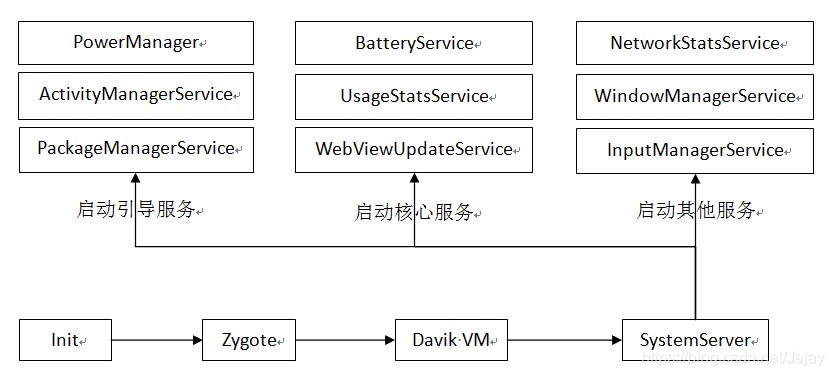Zygote字面意思是“受精卵、接合子”,生物学中意味着一个新生命的诞生。Android系统中也有一个进程叫Zygote,它的主要功能就是在Android系统中产生并运行新的进程。
Android是基于Linux内核的,Android系统上电启动之后,首先Linux内核启动,然后在用户空间启动init进程,init进程启动完一些系统守护进程之后,就会启动Zygote进程,启动Dalvik虚拟机,之后转到java层运行ZygoteInit的main方法。ZygoteInit源码位于:
frameworks/base/core/java/com/android/internal/os/ZygoteInit.java
下面我们就通过这个类的部分源代码,分析其一些主要流程,先看main方法:
public static void main(String argv[]) {
...
try {
...
// 1、注册Socket,用于接收新的app启动请求
registerZygoteSocket(socketName);
...
// 2、预加载Android Framework的class和Resource
preload();
...
// 3、启动SystemServer
if (startSystemServer) {
startSystemServer(abiList, socketName);
}
...
// 4、处理新的app启动请求
runSelectLoop(abiList);
closeServerSocket();
} catch (MethodAndArgsCaller caller) {
// 5、新进程启动,要运行main方法时,会抛出MethodAndArgsCaller
caller.run();
} catch (Throwable ex) {
Log.e(TAG, "Zygote died with exception", ex);
closeServerSocket();
throw ex;
}
}步骤1、注册Socket,用于接收新的app运行请求。AMS启动新的Activity的时候,根据需要会启动对应app,启动app最终调用到frameworks/base/core/java/android/os/Process.java的startViaZygote,里面会通过发送Socket请求启动新的app。步骤1这边的注册就是为了监听这个请求。
步骤2、初始化了BootClassLoader,并将Framework中的class和drawable等预加载出来。使得新的进程可以直接使用这些类和资源,加快了程序运行。
步骤3、native层运行ZygoteInit的main方法时,会传入参数“start-system-server”,这边就会调用startSystemServer启动系统服务
步骤4、监听Socket请求,有请求就执行,并循环继续监听
步骤5、子进程启动之后,要运行主入口的main方法时,会抛出MethodAndAnrgsCaller,这边接收执行。后面会详细讲到这个设计
步骤1和2比较简单,有兴趣同学自己去看源码,今天我们主要看步骤3和5,4的话和3类似
接下来看看步骤3的startSystemServer方法重要步骤源码:
private static boolean startSystemServer(String abiList, String socketName)
throws MethodAndArgsCaller, RuntimeException {
...
// 1、准备参数
String args[] = {
"--setuid=1000",
"--setgid=1000",
"--setgroups=1001,1002,1003,1004,1005,1006,1007,1008,1009,1010,1018,1021,1032,3001,3002,3003,3006,3007,3009,3010",
"--capabilities=" + capabilities + "," + capabilities,
"--nice-name=system_server",
"--runtime-args",
"com.android.server.SystemServer",
};
ZygoteConnection.Arguments parsedArgs = null;
int pid;
try {
parsedArgs = new ZygoteConnection.Arguments(args);
ZygoteConnection.applyDebuggerSystemProperty(parsedArgs);
ZygoteConnection.applyInvokeWithSystemProperty(parsedArgs);
// 2、孵化systemServer进程
pid = Zygote.forkSystemServer(
parsedArgs.uid, parsedArgs.gid,
parsedArgs.gids,
parsedArgs.debugFlags,
null,
parsedArgs.permittedCapabilities,
parsedArgs.effectiveCapabilities);
} catch (IllegalArgumentException ex) {
throw new RuntimeException(ex);
}
// 3、子进程运行
if (pid == 0) {
...
handleSystemServerProcess(parsedArgs);
}
return true;
}步骤1、准备参数,前几个就是设置进程的userId,groupId,权限等,最后一个没有带“--”的表示要新进程启动之后要运行的入口类,也就是最终新进程会运行这个类的main方法
步骤2、调用jni方法孵化新进程。新进程创建成功之后,会共享和复制父进程的内存信息,包括PC计数都会一样,所以新进程一诞生就会从这边开始执行。因此如果在这个方法之后打印log的话,会发现会打印两次。一次是新进程,返回的pid是0;一次是原进程(父进程),返回值是新进程的pid。
TIP:新进程创建之后,这里内存共享和复制采用一种叫COW(Copy On Write)技术。一般来说,复制内存开销非常大,所以子进程会先和父进程共享内存,只有当需要修改共享内存信息的时候,子进程才会将父进程中的内存信息复制到自身内存空间。
步骤3、返回值pid是0,也就是现在是子进程运行到这里,那就继续执行systemServer进程。而父进程则直接返回,进入main方法步骤4监听新app启动的Socket请求
步骤3的handleSystemServerProcess方法重要步骤源码:
private static void handleSystemServerProcess(
ZygoteConnection.Arguments parsedArgs)
throws ZygoteInit.MethodAndArgsCaller {
// 1、子进程关闭Socket
closeServerSocket();
...
if (parsedArgs.invokeWith != null) {
// 指定运行命令,则运行。
} else {
...
// 2、正常走这里,运行目标类SystemServer的main方法
RuntimeInit.zygoteInit(parsedArgs.targetSdkVersion, parsedArgs.remainingArgs, cl);
}
/* should never reach here */
}
步骤1、由于子进程是父进程孵化而来,所以也带有监听socket功能,所以这里将其关闭掉。
步骤2、初始化Zygote并运行目标类SystemServer的main方法
看看RuntimeInit的zygoteInit方法,位于
frameworks/base/core/java/com/android/internal/os/RuntimeInit.java
public static final void zygoteInit(int targetSdkVersion, String[] argv, ClassLoader classLoader)
throws ZygoteInit.MethodAndArgsCaller {
...
applicationInit(targetSdkVersion, argv, classLoader);
} private static void applicationInit(int targetSdkVersion, String[] argv, ClassLoader classLoader)
throws ZygoteInit.MethodAndArgsCaller {
...
// 1、设置虚拟机一些参数
VMRuntime.getRuntime().setTargetHeapUtilization(0.75f);
VMRuntime.getRuntime().setTargetSdkVersion(targetSdkVersion);
final Arguments args;
try {
// 2、解析之前孵化前设置的参数
args = new Arguments(argv);
} catch (IllegalArgumentException ex) {
Slog.e(TAG, ex.getMessage());
// let the process exit
return;
}
...
// 3、调用目标类(SystemServer)的main方法
invokeStaticMain(args.startClass, args.startArgs, classLoader);
}步骤2、解析之前startSystemServer中的参数,其中最后一个参数“com.android.server.SystemServer”将会解析到 arg的startClass
步骤3、调用目标类的静态main方法
private static void invokeStaticMain(String className, String[] argv, ClassLoader classLoader)
throws ZygoteInit.MethodAndArgsCaller {
Class<?> cl;
try {
cl = Class.forName(className, true, classLoader);
} catch (ClassNotFoundException ex) {
throw new RuntimeException(
"Missing class when invoking static main " + className,
ex);
}
Method m;
try {
m = cl.getMethod("main", new Class[] { String[].class });
} catch (NoSuchMethodException ex) {
throw new RuntimeException(
"Missing static main on " + className, ex);
} catch (SecurityException ex) {
throw new RuntimeException(
"Problem getting static main on " + className, ex);
}
int modifiers = m.getModifiers();
if (! (Modifier.isStatic(modifiers) && Modifier.isPublic(modifiers))) {
throw new RuntimeException(
"Main method is not public and static on " + className);
}
throw new ZygoteInit.MethodAndArgsCaller(m, argv);
}解析:通过反射机制获取目标类的静态方法main,最后创建并抛出一个MethodAndArgsCaller异常
我们再看看MethodAndArgsCaller的源码:
public static class MethodAndArgsCaller extends Exception
implements Runnable {
/** method to call */
private final Method mMethod;
/** argument array */
private final String[] mArgs;
public MethodAndArgsCaller(Method method, String[] args) {
mMethod = method;
mArgs = args;
}
public void run() {
try {
mMethod.invoke(null, new Object[] { mArgs });
} catch (IllegalAccessException ex) {
throw new RuntimeException(ex);
} catch (InvocationTargetException ex) {
Throwable cause = ex.getCause();
if (cause instanceof RuntimeException) {
throw (RuntimeException) cause;
} else if (cause instanceof Error) {
throw (Error) cause;
}
throw new RuntimeException(ex);
}
}
}
解析:这是一个异常,并实现Runnable方法,其中run方法就是反射调用目标函数(main方法)
回到RuntimeInit的invokeStaticMain方法的最后一行抛出MethodAndArgsCaller之后,到ZygoteInit的main方法的步骤5进程catch并运行里面的run方法。
这样设计的原因是,这个进程目标类的main方法抛出异常的的时候,可以清空上面的这些方法的调用栈,让分析者感觉是ZygoteInit的main方法直接调用执行的
SystemServer源码:位于frameworks/base/services/java/com/android/server/SystemServer.java,我们看看main方法主要流程:
public static void main(String[] args) {
new SystemServer().run();
}
...
private void run() {
...
// Start services.
try {
// 启动引导服务
startBootstrapServices();
// 启动核心服务
startCoreServices();
// 启动其他服务
startOtherServices();
} catch (Throwable ex) {
throw ex;
} finally {
Trace.traceEnd(Trace.TRACE_TAG_SYSTEM_SERVER);
}
...
}最后附上一张大致启动流程图

到这里,我们大致了解了从ZygoteInit到运行各种SystemServer的基本流程。





















 1104
1104

 被折叠的 条评论
为什么被折叠?
被折叠的 条评论
为什么被折叠?








